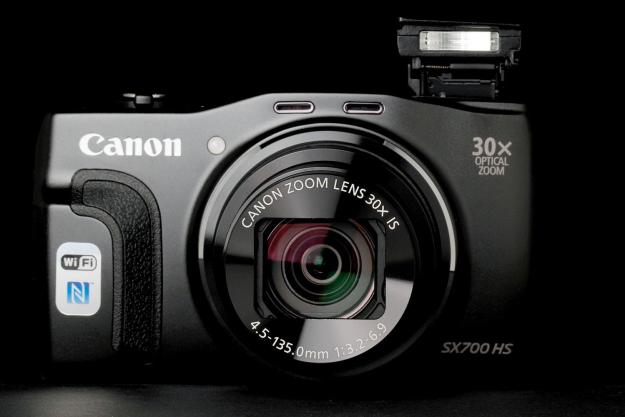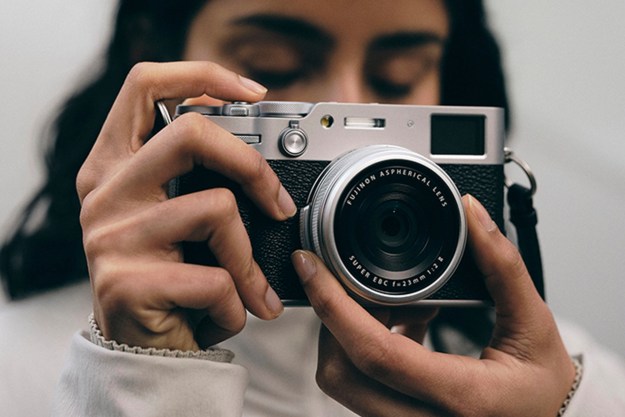
“Pocket-friendly it may not be, but what you get in the Canon PowerShot SX700 HS is a strong compact camera with a terrific long lens that produces great images and videos.”
- Terrific image quality
- Very good videos
- Quality 30x zoom lens
- Not great with low light
- Creative Shot effects are so-so
- LCD isn’t touchscreen, doesn’t flip out
When it comes to advancements in the point-and-shoot world, it’s all about high-end cameras with premium and unique features. Canon’s PowerShot SX700 HS ($350), a compact shooter with a long-zoom 30x lens, demonstrates where the company is currently concentrating its resources (not with basic models like the PowerShot ELPH 340 HS). With the SX700, Canon uses a quality lens that delivers excellent image quality, even at full telephoto (provided you have plenty of light). If you’re shopping for a new compact camera that delivers a bit more than what you’ll find in a smartphone or pocket camera, the SX700 is one you should consider.
Features and design
While classified as a compact camera, the SX700 is by no means pocket-friendly like a Canon ELPH camera, nor is it light, at 9.5 ounces (with battery). You could shove it down the pocket of your pants, but that chunky form factor (approximately 4.4 x 2.6 x 1.4 inches) won’t make it very comfortable. Overall, the camera has a good albeit hefty feel in the hand. Once in your hand, all the controls are easily accessible by your right thumb.
The camera is thick in order to accommodate the long 30x zoom, but it’s a tradeoff we’d gladly make.
Of course, a camera needs to be fairly thick if it’s going to accommodate that long 30x zoom and all that glass, but it’s a tradeoff we’d gladly make. It used to be that in order to get a long zoom, you’d have to carry around a DSLR-like bridge camera (it’s still the case if you want a super-zoom lens). While it may not be slim and sexy like some pocket cameras, it’s still highly portable. And, you get the benefit of a lens that’s 25-750mm equivalent, with an aperture range of f/3.2-6.9. With a long lens like this, it’s difficult to keep steady at full telephoto, when handheld. To counter shaking, the SX700 has optical image stabilization, and it works well.
Inside the SX700 is a 16.1-megapixel, 1/2.3-inch CMOS sensor. It’s not a particularly large sensor – a typical size in point-and-shoot cams – but Canon pairs it with its latest image processor, the Digic 6. Even though it uses the same sensor as the ELPH 340 HS, the SX700 is far stronger performer for both stills and Full HD 1080/60p, thanks to the combination of sensor, image processor, and lens.
While we imagine many of the SX700’s intended users would most likely be sticking with the automatic mode, the camera does offer more advanced shooting modes when you need to take greater control of the camera (aperture, shutter speed, exposure compensation, ISO, etc.). There’s Program, Aperture Priority, Shutter Priority, and Manual (PASM). This can be accessed through the dial on the top-right rear of the camera. You can easily switch between modes by turning the dial, but it’s a quite stiff and requires a bit of effort. Besides PASM and auto, there are others like Scene (auto settings based on environment conditions), Creative Shot (capturing multiple shots of same image with different filters and effects; the camera controls this), Movie, Sports (continuous shooting of action), and Live View Control (customize brightness or colors).
As a camera, the SX700 doesn’t look any different than other compact cameras. On the front are the retracting lens barrel and a small grip for your fingers. The top has a pop-out flash, and shutter and dedicated movie buttons, and there are the various buttons for changes settings and accessing/navigating menus on the back. There are two buttons that are worth noting, however: Framing Assist and Mobile device. When you zoom all the way out toward a subject, it’s very easy to lose that subject within the frame, even with just a slight movement of the camera. Hitting the Framing Assist button on the side of the camera pulls the zoom back a bit, to help you locate the subject; once you’ve located and focused onto the subject, the zoom pushes back out. We found this feature to work as advertised.
The other button lets you enter into a wireless connection either directly to an often-used smart device or wireless network. On first use, you’ll need to set it up by manually pairing the camera with the device. The SX700 also comes with near-field communication (NFC), allowing you to “tap” it with a compatible device; we successfully paired the camera with a Samsung Galaxy S5 smartphone, where upon touching the two together, the S5 searched for the necessary Canon app and completed the pairing.
Canon’s Wi-Fi implementation is still behind Sony and Samsung’s in terms of usefulness and ease-of-use, but it has improved, enabling you to transfer images and operate the camera remotely by putting basic controls and Live View on your phone. When using a smartphone, you can also log GPS location info onto photos, but this is a feature that we can never seem to get to work properly. Overall, we got the camera to pair up with our devices (although there were occasions where we had some trouble), and we were able to send photos to our phones for uploading to social networks, as well as remote operation.

On the back, you’ll find the 3-inch LCD that’s rated 922k-dot resolution. We found the LCD to be very bright and sharp, with wide viewing angles. Even under bright sunlight, it was easy to see clearly. It isn’t touch capable, which we didn’t find detrimental except for times when we had to input characters during Wi-Fi setup. The screen also doesn’t flip out like many new cameras today. The SX700 uses the same menu system shared with most other PowerShot models, which we sometimes find tedious as it requires you to scroll and drill through sub-menus. We would love to see a Q or Fn button that takes us to the settings options that are most often used.
What’s in the box
These days, Canon doesn’t include a lot of superfluous items. You get the camera, battery pack, battery charger, wrist strap, and a few printed documents like the quick-start guide. Software can be downloaded from Canon’s website.
Warranty
Canon includes a limited one-year warranty. More details can be found here.
Performance and use
The SX700 snaps into action fairly quick, in less than a second. We used the camera in various modes, from full auto and PASM to Creative Shot. Like any basic camera, there isn’t much to mess around with in the automatic modes. The Creative Mode gives you images an artistic look by applying filters and effects onto your photos, shooting a scene with six different looks. But we didn’t really care for the resulting looks – they don’t have that same cool vibe that Instagram filters offer – but that’s our personal opinion. In the PASM modes, you can adjust the various settings within each mode directly by using the control wheel, but you’ll need to enter the function menu to adjust white balance or ISO. Regardless of the mode you use, it’s not a difficult camera to operate.
Photos are excellent, with vibrant colors…everything looks sharp and nicely detailed.
We were absolutely delighted by the 30x zoom, not just because of the wide focal range it afforded us, but how good our photos came out, even at full telephoto. We recently took a look at the Samsung WB350F, a compact camera with a 21x zoom. At full zoom, the WB350F’s photos didn’t exhibit the brilliant sharpness we saw with the SX700. Pushed all the way to 30x, the SX700 can be a bit hard to keep still, but Canon’s optical image stabilization system works incredibly well, and it shows in the images, which held up nicely in our samples. We shot a tag with text from more than 6 feet away, and the text came out clear and legible. The only image that didn’t look as detailed was of an airplane flying overhead, but we’re talking 5,000 feet and it still came out OK.
Image quality wise, the SX700 produces excellent photos, reminding us of what we’d get from the PowerShot S-series of cameras with larger sensors. Colors are vibrant (if just a teeny bit undersaturated), and everything looks sharp and nicely detailed. When you get in close at actual size, you can make out some imperfections like soft edges and some detail loss, but for most users, they’re hardly noticeable and don’t take away from the overall image quality. Most people view images at smaller sizes anyway, and you won’t have issues printing 8.5×11-size images that look great. Although the camera doesn’t have a wide aperture range, we were able to get some nice close-ups with some bokeh blurring effect, meaning you can shoot some good portraits.
However, where the SX700 falters is in low light. The camera has an ISO range of 100-3,200, with only 1-step increments (100, 200, 400, 800, etc.). By 800, the camera already starts to stumble. It had problems trying to focus on objects. We shot a few night photos at auto ISO, and the camera selected 1,600 for all of them. The photos produced were blurry and noisy, and had lost nearly all details when viewed in full; they looked more like Impressionist paintings. With that said, if we dropped the size down to 25 percent of actual size, the photos are perfectly salvageable.
If you want to capture action, the SX700 may not be able to keep up, depending on what you’re shooting. A slow dance may be fine, but not so much for a fast-moving car. The camera has a continuous shooting speed of 3 frames per second, but slows down to about 1 fps if you enable autofocus with tracking.
The SX700 can shoot video at Full HD 1080 at 60p, in the MP4 format, which is a step-up from the 30p of previous Canon compacts. In general, video quality is very good. The audio is also good, thanks to the onboard stereo mics, and it didn’t capture any unwanted sound that the camera makes. Having a 30x zoom can also be real handy here. You’ll notice some video hesitation if you pan or zoom very quickly, but unless you’re a videography stickler, the video quality should satisfy most users.
As for battery life, Canon rates the SX700 250 shots (360 if you use the ECO mode, which put the camera on standby more often, for efficiency). It’s OK, and with casual use, you can get a couple days or so before you should recharge. But if you’re traveling and sightseeing, and leaving the camera on at all times, you should remember to recharge at the end of the day.
Conclusion
We have been worried about Canon’s compact cameras, wondering if the company even cares about the category anymore. The PowerShot ELPH 340 HS we recently reviewed left much to be desired. But with the SX700, it shows that Canon is putting its resources not in budget models, but in more advanced offerings (as are most camera companies). At $350, the SX700 is slightly pricier than many compact cameras, but, for the price, you get a terrific long-zoom camera that delivers very good-to-excellent images and video. The SX700 has advantages over smartphones and lesser digicams, but don’t expect it to perform miracles in low light.
Highs
- Terrific image quality
- Very good videos
- Quality 30x zoom lens
Lows
- Not great with low light
- Creative Shot effects are so-so
- LCD isn’t touchscreen, doesn’t flip out










